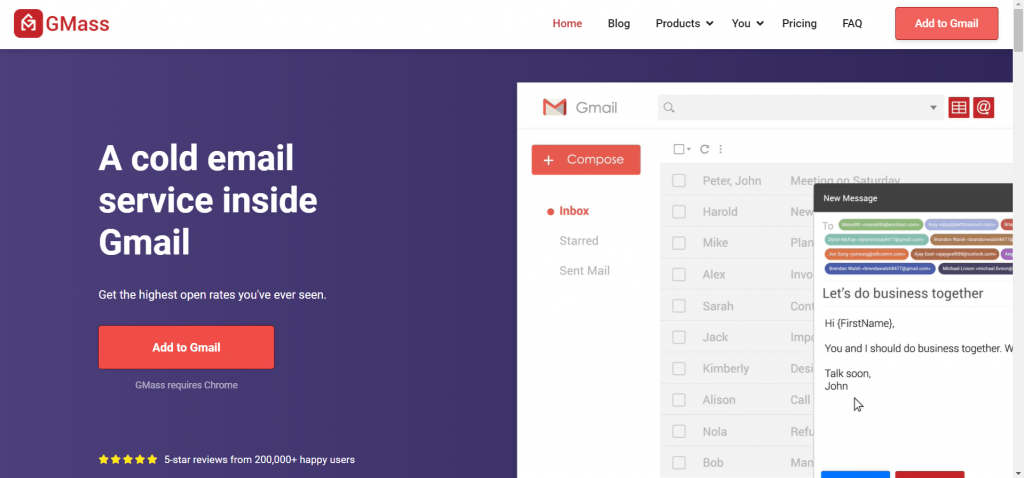
The lead vs. prospect comparison continues to stump many sales and marketing teams.
Some assume that both terms mean the same thing, while others struggle to pinpoint the difference between prospects and leads.
Essentially, the differences boil down to how sales-ready they are.
And when it comes to closing sales, how you convert a lead into a prospect is what matters.
In this article, I’ll cover the basic definitions of leads and prospects and clarify how a lead differs from a prospect and a sales opportunity. I’ll also show you how to convert leads to prospects and provide seven actionable tips for successful lead conversion.
This Article Contains:
(Click on the links below to jump to specific sections.)
- What Is a Lead?
- What Is a Prospect?
- Lead vs. Prospect: 4 Key Differences
- Lead vs. Prospect vs. Sales Opportunity
- How to Convert a Lead into a Prospect
- 7 No-Nonsense Tips for Effective Lead Conversion
Let’s dive right into it.
What Is a Lead?
A lead (also known as an unqualified contact) is any person or business that might be interested in your product or service and could become a potential customer.
Note: a contact refers to any individual or business engaging with your company.
Leads might provide you their basic contact details by filling an online form (lead capture form) or responding positively to cold calls. They are at the most basic level of the sales process.
Usually, there are three types of leads:
- Information Qualified Lead (IQL): IQLs provide their contact details in exchange for some awareness-level piece of information you provide through case studies, white papers, or ebooks, etc.
- Marketing Qualified Lead (MQL): MQLs are secured through inbound marketing and demand generation efforts like ads, social media marketing campaigns, or blog posts. They are usually hand-raisers who have an active interest in your offerings.
- Sales Qualified Lead (SQL): SQLs are ready to engage directly with a sales representative. They are willing to provide additional details and are relatively further down the sales funnel.
In any case, the successful conversion of your leads into prospects depends on how you handle them.
But before we get to that, I’ll explain what a prospect is.
What Is a Prospect?
By definition, prospects are qualified contacts who are on the way to make a buying decision.
A prospect is a more sales-ready lead that fits your ideal customer profile and buyer persona.
What is an ideal customer profile?
An ideal customer profile (ICP) represents your target market and the essential criteria that a lead must fulfill to become your customer.
For example, to become an ideal prospect for Company X, which sells a B2B product, a lead must:
- Be part of a particular industry, like HR software
- Have a minimum of 100 employees
What is a buyer persona?
A buyer persona is a research-based representation with all qualities that a potential customer must ideally fulfill. It helps you identify specific types of customers within your target market.
For example, to become a prospect, the lead might need to:
- Be part of a mid-sized company’s marketing team
- Stay in London
- Be aged 30 to 40 years old
A well-nurtured lead becomes a prospect, and a well-engaged prospect can transform into a sales opportunity.
Now that we have a basic understanding of these terminologies, let’s see how a lead differs from a prospect.
Lead vs. Prospect: 4 Key Differences
The terms leads and prospects are often used interchangeably in sales circuits, even though they mean different things.
But to establish an effective sales process, it’s necessary to understand what distinguishes a lead from a prospect.
Here are the four significant differences between leads and prospects:
A. Contact Qualification
Leads are unqualified contacts who you haven’t fully initiated into the sales cycle. They haven’t committed yet, and you only have limited information about them.
On the other hand, a prospect is a qualified lead that the marketing team has usually nurtured.
The prospects fit your buyer persona and ideal customer profile and have a higher chance of advancement in the sales cycle. Moreover, a prospect usually has additional details about your product or service to make an informed choice and is a potential customer.
B. Contact Handling
The marketing team is responsible for handling your leads.
Since leads are at the preliminary stage of the sales process, the marketing department can provide them with more information about how your offering will be helpful.
In contrast, both the marketing and sales teams handle prospects. While the marketing department manages them until the nurturing stage, the sales department takes them on until the deal has a chance of closing.
C. Communication
With leads, there is usually one-way communication.
Once a lead expresses interest and provides their details, you give them additional content relevant to their needs. They remain engaged with limited dialogue during the lead stage.
Interactions with leads are through general channels like social media, and calls to action provide additional resources. Leads are usually contacted in bulk and offered non-specific content since they haven’t revealed their definitive interest.
By contrast, two-way communication dominates most interactions with prospects.
When a prospect raises questions about specific aspects of the offering, a sales rep answers their queries and provides all the required information. Here, interactions are more personalized to the needs of the prospect.
The sales team typically contacts them on one-on-one channels like emails, and calls to action are customized to turn prospects into loyal customers.
D. Position in the Sales Funnel
A sales funnel refers to a potential customer’s journey as they pass through different sales process steps. The funnel reflects the number (or percentage) of leads going through each stage of the process.
Now, leads are positioned at the top of the sales funnel since they are at the starting point of the buying process. They have to pass through several stages before becoming customers.
On the other hand, prospects (sales-ready leads) are relatively further down the sales funnel. They’re qualified to be part of the later stages — like talking to a salesperson — and are only a few steps away from becoming a sales opportunity.
But how is a lead or a prospect different from a sales opportunity?
Lead vs. Prospect vs. Sales Opportunity
A sales opportunity is a qualified prospect who’s further along the sales cycle and is prepared to make a purchase decision. They are ready for a sales call or sales pitch.
Essentially, the progression usually looks like this:
Lead → Prospect → Sales opportunity
Keep in mind that you can convert a prospect into a sales opportunity only if the prospect has a goal or challenge that your offering can actually help resolve. And before a lead gets to the sales opportunity stage, you must first convert them into a sales prospect.
How do you do that?
Let’s find out.
How to Convert a Lead into a Prospect
Whether you’re a small business owner or a salesperson in a large company, remember that not every lead is an ideal fit for your company.
That’s why most sales cycles have a lead qualification stage.
It helps you identify which leads generated during lead generation are genuinely worth pursuing. You can then nurture these leads into prospects.
Here’s a closer look at these processes:
A. Lead Qualification
Lead qualification lets you identify leads who are likely to turn into clients through the sales process. You can do this by asking them a qualifying question to see if they fit your buyer persona and ideal customer profile.
For example, you could ask them how much they are willing to spend on a solution to their problem.
The qualification process ensures that you spend time only on viable leads, and it removes unqualified leads from the sales cycle.
B. Lead Nurturing
Lead nurturing involves building meaningful business relationships with leads by providing them relevant and timely information. This stage develops an immediate connection with your leads, prepares them for B2C or B2B sales, and moves them into the prospect stage.
You can nurture leads through digital marketing activities like automated email campaigns and social media engagements.
Now that you know about qualifying and nurturing leads, I’ll provide some actionable tips to convert them into prospects effectively.
7 No-Nonsense Tips for Effective Lead Conversion
Here are seven tips that sales managers and representatives can use for efficient lead conversion:
1. Improve Lead Data Collection
One of the most crucial steps to turn a lead into a sales prospect is data collection.
Collecting all relevant details about your leads helps your sales representative determine whether they fit your ideal customer profile and buyer persona or if they’re just unqualified leads.
You can collect data like:
- Email addresses
- Phone book details
- Social media profiles
- Job designation
- Employer name
- Company revenue
- The number of employees
- Location, and more
This information can help your salesperson decide if you’ve got a qualified lead or not.
It also allows your marketing and sales professionals to adapt their marketing strategy and B2C or B2B sales tactics to convert a qualified lead effectively.
2. Use Segmentation
While no two leads will be the same, many behave similarly.
So, it’s better to categorize or segment leads to save time. Some of those needs may align nearly perfectly with your buyer persona, making those leads more promising than others for your sales team.
For segmenting leads, your sales professionals can use lead scoring to rank them based on how likely they’re to buy from you and the potential size of the sale. Based on the lead scoring data, your sales rep can easily segment leads into different categories.
Customer segmentation based on lead scoring allows your sales representative to focus on your most qualified lead segment, which will ultimately contribute the most value to your business.
3. Create High-Quality Content
Sometimes, leads in your target audience turn cold because the content you shared with them failed to inspire or excite them.
That’s why it’s crucial to create high-quality, relevant content and upgrade it to keep leads engaged in the sales process. This can help accelerate lead conversion from your target audience more organically than any other sales or digital marketing strategy.
Additionally, the content your marketing team creates can help with demand generation through inbound marketing efforts like blog posts and whitepapers, etc.
4. Pay Attention to Analytics
Keeping track of analytics gives you information on the efficacy of your current marketing and sales efforts.
For example, you can analyze metrics like first-time visitor conversion percentage, landing page bounce rate, and positive responses from commenters on blog posts. Based on the data, your marketing team and sales force can identify underperforming areas and revamp them.
Moreover, lead conversion data also helps your sales team develop a better lead scoring methodology for the future.
5. Provide Problem Solving Assistance and Flexibility
One of the most crucial aspects of moving a lead into the prospect stage is your readiness to solve their problems.
Your salesperson should be ready to answer any questions raised by your sales qualified lead in a timely fashion before the lead turns away.
You must also be flexible enough to adapt to the requirements of your sales lead.
For example, B2B sales leads differ from B2C leads, and both require a different sales or marketing strategy. Your ability to customize the sales process to accommodate the type of potential prospect helps boost your lead conversion rate.
6. Engage with Leads on Social Media
To keep leads interested in your offering, you could engage with them on social media. Its non-intrusiveness works better than traditional strategies like cold calling (making unsolicited phone calls).
And instead of overwhelming people in your target market with a sales pitch, you can share instructive and valuable information curated to their needs on your social media accounts.
This makes it easier to generate a sales qualified lead for your business and foster a relationship of trust.
7. Leverage Sales Enablement and Automation Software
Typically, qualifying a sales lead from your target market and engaging with a sales prospect requires a lot of time and effort.
Fortunately, you can use the right software solutions to automate processes like sales prospecting and lead generation.
You can use email capture software such as OptinMonster and email-finding tools like Voila Norbert to manage your lead generation activities.
You can also use sales prospecting tools like Leadfeeder and Datanyze to qualify leads easily, advance them along the sales funnel, and convince them to make a purchase decision.
Additionally, effective software solutions like Pipedrive or Salesforce can help with Customer Relationship Management (CRM) and sales forecasting.
You can also use cloud-based appointment scheduling software such as Calendly or AppointmentPlus to establish contact with a potential client.
And for marketing automation, you can use a powerful email marketing tool like GMass.
What’s GMass?

GMass is a robust email outreach and marketing automation tool that helps you manage your email campaigns right inside Gmail.
This way, you don’t have to spend time learning a new marketing or sales system to connect with a potential prospect.
Used by employees at global tech giants like Google and Uber and social media platforms like Twitter and LinkedIn, GMass is also perfect for a startup, a small business, and individual sales professionals.
Besides its affordable pricing model, GMass offers a collection of features, including:
- Automatic personalization of your marketing or sales emails, including attachments, paragraphs, and links. This makes it easy to send personalized cold emails for sales conversations.
- Send automated follow-up emails customized to the behavior of a particular sales contact. For example, if a qualified prospect doesn’t open your previous email, you can send them an automated follow-up email to restate the offer.
- Analytics reports to analyze the deliverability and engagement metrics of your email marketing campaigns.
- Overcome Gmail’s email sending limit so that your sales rep can establish email contact with every potential sales lead or sales prospect.
- Schedule your emails so that a potential client from your target audience gets them at the right time.
- Easily integrate with CRM tools like Salesforce to manage prospect and lead data from one place.
- Powerful add-on for the Gmail Android app lets you manage your marketing campaigns right from your smartphone.
To sum up, with GMass, you can easily enhance your chances of converting your sales lead to a potential client. To start using GMass, download the Chrome extension and sign up for a free trial using your Gmail account.
Final Thoughts
When it comes to optimizing your sales strategy, it’s essential to understand how leads and prospects are different.
And while efficient lead conversion can seem challenging, you can use the time-tested tips I covered here to help you secure those reluctant prospects.
That’s also where email outreach and marketing automation tools like GMass come into play.
With GMass, you can send out automated email marketing campaigns, schedule follow-ups, analyze email outreach performance, and do so much more.
Why not try GMass today and start converting leads into prospects efficiently?
Email marketing, cold email, and mail merge all in one tool — that works inside Gmail
TRY GMASS FOR FREE
Download Chrome extension - 30 second install!
No credit card required










